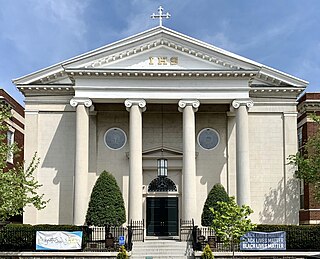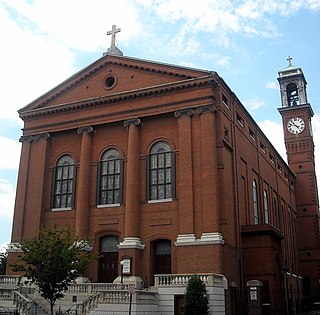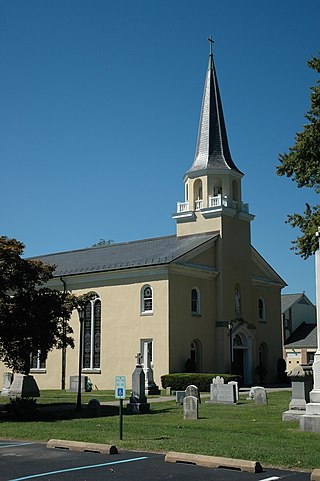
Michael Francis Egan was an Irish American Catholic prelate who served as Bishop of Philadelphia from 1808 until his death.

The Metropolitan Cathedral Church of Saint Andrew or Glasgow Metropolitan Cathedral is a Latin Catholic cathedral in the city centre of Glasgow, Scotland. It is the mother church of the Archdiocese of Glasgow. The cathedral, which was designed in 1814 by James Gillespie Graham in the Neo-Gothic style, lies on the north bank of the River Clyde in Clyde Street. St Andrew's Cathedral is the seat of the Archbishop of Glasgow, currently William Nolan. It is dedicated to the patron saint of Scotland, Saint Andrew.

Patrick Augustine Feehan, was an Irish-born American prelate of the Roman Catholic Church. He served as the first archbishop of the newly-elevated Archdiocese of Chicago in Illinois between 1880 and his death in 1902. He previously served as bishop of the Diocese of Nashville in Tennessee from 1865 to 1880.

Holy Trinity Catholic Church is a Catholic church run by the Jesuit order that is located in the Georgetown neighborhood of Washington, D.C., in the United States. Holy Trinity Parish was founded in 1787 and is the oldest Roman Catholic community and house of worship in continuous operation both in Georgetown and in the larger city of Washington, D.C. The original church building was completed in 1794. It is now called the Chapel of St. Ignatius, and is used for smaller ecclesiastical celebrations and as an auxiliary space for parish activities. A larger church building, necessitated by the growing community, was dedicated in 1851, and still serves as the parish church today.

St. Aloysius Catholic Church is a Roman Catholic parish church at 19 I Street in the Near Northeast neighborhood of Washington, D. C. It is administered by the Jesuits since its founding and is named for St. Aloysius Gonzaga. It is often associated with Gonzaga College High School, to which it is physically connected. The church building is listed on the National Register of Historic Places. In 2012 the parish was closed and merged with Holy Redeemer church.

The Sacred Heart Church, Rectory, School and Convent make up a historic Roman Catholic church complex in Cambridge, Massachusetts. The church was built in the 1870s and 1880s to serve the parish first organized as the St. John the Evangelist Parish in 1842. The cornerstone of the church was laid on 4 October 1874. It was dedicated in 1883, and opened for Divine Service on 12 November 1876. The rectory was added in 1885, and the convent and school followed in 1902. The church is a Medieval Gothic structure designed by P. W. Ford. The complex occupies an entire city block, and has been partly taken over for Cambridge city school administration.

Ignatius Frederick Horstmann was an American prelate of the Roman Catholic Church. He served as bishop of the Diocese of Cleveland in Ohio from 1892 until his death in 1908.

St. Joseph on the Brandywine, originally Saint Joseph's Church until St. Joseph's Church- Wilmington was built in 1947, is a parish of the Catholic Church in Greenville, Delaware, United States, in the Diocese of Wilmington. It is a historic parish church complex and national historic district located on Old Church Road. Since 2002 its old convent building has housed the diocesan archives, with records going back two centuries. It is also the home parish of the 46th President of the United States, Joe Biden.

Immaculate Conception Catholic Church is a historic Catholic parish in the United States in Washington, D.C. Located at 1315 8th Street Northwest, the church, school, rectory, and convent were placed on the National Register of Historic Places in 2003.
The Church of St. Martin de Porres is a Roman Catholic parish church under the authority of the Roman Catholic Archdiocese of New York, located in Poughkeepsie, Dutchess County, New York.

The Old Church of St. Peter is a Roman Catholic church established under the authority of the Roman Catholic Archdiocese of New York in Poughkeepsie, Dutchess County, New York in 1837. It is the second oldest Catholic Church on the Hudson and is considered the Mother Church of the Hudson Valley because from it all the parishes in Ulster and Dutchess counties were founded. The church is also referred to as Our Lady of Mount Carmel since 1965 when St. Peter's parish relocated to Hyde Park, New York and the parish of Our Lady of Mount Carmel church relocated to site.
The Church of St. Mary is a Roman Catholic parish church under the authority of the Roman Catholic Archdiocese of New York, located in Wappingers Falls, Dutchess County, New York. It was canonically established in 1845.

The Church of Our Lady of Mount Carmel is a historic Roman Catholic parish church building located in Poughkeepsie, Dutchess County, New York.

The Church of St. Mary is a former Roman Catholic parish church under the authority of the Roman Catholic Archdiocese of New York, located at White Plains Road at 215th Street in Williamsbridge, Bronx, New York City, New York. The church served the Williamsbridge area along with a parish school on East 215th Street, and later in the 1950s was closed and relocated to Carpenter Avenue and East 224th Street to accommodate the growing student population and shift of parishioners. The parish church was closed partly due to the community's changing demographics in the 1990s, reducing the Catholic population to a point where the Archdiocese of New York could no longer support a Catholic parish in the area.
St. Mary Parish is a Roman Catholic church in Bridgeport, Connecticut, part of the Diocese of Bridgeport.

St. Peter is a Roman Catholic church in Danbury, Connecticut, part of the Diocese of Bridgeport. St. Peter's was the first Catholic church built in northern Fairfield County. It is the third oldest parish, and the fifth oldest Roman Catholic Church in the Diocese of Bridgeport. St. Peter's was originally a predominantly Irish congregation. Danbury's Annual St. Patrick's Day Parade steps off in front of St. Peter's. In more recent time, the parish has a significant number of parishioners of Latino and Brazilian heritage.

St Patrick's Catholic Church is a Roman Catholic parish in Washington, District of Columbia, United States of America. Established in 1794, it is the oldest Catholic parish in the city of Washington.

Saint Stephen Martyr Catholic Church is a Catholic parish church located at 2436 Pennsylvania Avenue NW in Washington, D.C., in the United States. The parish was founded on August 4, 1867, and the first church building consecrated and used for worship on December 27, 1868. This brick structure closed on July 15, 1959, and the current new building was consecrated and first used for worship on June 11, 1961. The church was a favorite of President John F. Kennedy.

The Church of St. Joseph is a Roman Catholic church located in the Village of Bronxville in Westchester County, New York. Officially founded as a parish of the Archdiocese of New York in 1922, the Church of St. Joseph consists of the parish church, adjacent parochial St. Joseph School, rectory, and parish center. It serves residents of Bronxville as well as residents of nearby neighborhoods in Eastchester and Yonkers. St. Joseph's has a permanent chaplain to serve the needs of nearby Lawrence Hospital.

William Matthews, occasionally spelled Mathews, was an American who became the fifth Roman Catholic priest ordained in the United States and the first such person born in British America. Born in the colonial Province of Maryland, he was briefly a novice in the Society of Jesus. After being ordained, he became influential in establishing Catholic parochial and educational institutions in Washington, D.C. He was the second pastor of St. Patrick's Church, serving for most of his life. He served as the sixth president of Georgetown College, later known as Georgetown University. Matthews acted as president of the Washington Catholic Seminary, which became Gonzaga College High School, and oversaw the continuity of the school during suppression by the church and financial insecurity.





















